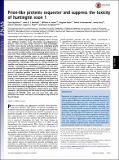| dc.contributor.author | Hesse, William R. | |
| dc.contributor.author | Shah, Jagesh Vijaykumar | |
| dc.contributor.author | Kayatekin, Can | |
| dc.contributor.author | Matlack, Kent E. S. | |
| dc.contributor.author | Guan, Yinghua | |
| dc.contributor.author | Chakrabortee, Sohini | |
| dc.contributor.author | Russ, Jenny | |
| dc.contributor.author | Wanker, Erich E. | |
| dc.contributor.author | Lindquist, Susan | |
| dc.date.accessioned | 2015-03-03T17:46:25Z | |
| dc.date.available | 2015-03-03T17:46:25Z | |
| dc.date.issued | 2014-08 | |
| dc.date.submitted | 2014-05 | |
| dc.identifier.issn | 0027-8424 | |
| dc.identifier.issn | 1091-6490 | |
| dc.identifier.uri | http://hdl.handle.net/1721.1/95753 | |
| dc.description.abstract | Expansions of preexisting polyglutamine (polyQ) tracts in at least nine different proteins cause devastating neurodegenerative diseases. There are many unique features to these pathologies, but there must also be unifying mechanisms underlying polyQ toxicity. Using a polyQ-expanded fragment of huntingtin exon-1 (Htt103Q), the causal protein in Huntington disease, we and others have created tractable models for investigating polyQ toxicity in yeast cells. These models recapitulate key pathological features of human diseases and provide access to an unrivalled genetic toolbox. To identify toxicity modifiers, we performed an unbiased overexpression screen of virtually every protein encoded by the yeast genome. Surprisingly, there was no overlap between our modifiers and those from a conceptually identical screen reported recently, a discrepancy we attribute to an artifact of their overexpression plasmid. The suppressors of Htt103Q toxicity recovered in our screen were strongly enriched for glutamine- and asparagine-rich prion-like proteins. Separated from the rest of the protein, the prion-like sequences of these proteins were themselves potent suppressors of polyQ-expanded huntingtin exon-1 toxicity, in both yeast and human cells. Replacing the glutamines in these sequences with asparagines abolished suppression and converted them to enhancers of toxicity. Replacing asparagines with glutamines created stronger suppressors. The suppressors (but not the enhancers) coaggregated with Htt103Q, forming large foci at the insoluble protein deposit in which proteins were highly immobile. Cells possessing foci had fewer (if any) small diffusible oligomers of Htt103Q. Until such foci were lost, cells were protected from death. We discuss the therapeutic implications of these findings. | en_US |
| dc.description.sponsorship | Howard Hughes Medical Institute | en_US |
| dc.description.sponsorship | National Institutes of Health (U.S.) (Grant GM25874) | en_US |
| dc.description.sponsorship | National Science Foundation (U.S.). Graduate Research Fellowship Program (Grant 1122374) | en_US |
| dc.description.sponsorship | G. Harold and Leila Y. Mathers Foundation | en_US |
| dc.description.sponsorship | Beckman Laser Institute Foundation | en_US |
| dc.description.sponsorship | Eleanor Schwartz Charitable Foundation | en_US |
| dc.description.sponsorship | Whitehead Institute for Biomedical Research | en_US |
| dc.language.iso | en_US | |
| dc.publisher | National Academy of Sciences (U.S.) | en_US |
| dc.relation.isversionof | http://dx.doi.org/10.1073/pnas.1412504111 | en_US |
| dc.rights | Article is made available in accordance with the publisher's policy and may be subject to US copyright law. Please refer to the publisher's site for terms of use. | en_US |
| dc.source | National Academy of Sciences (U.S.) | en_US |
| dc.title | Prion-like proteins sequester and suppress the toxicity of huntingtin exon 1 | en_US |
| dc.type | Article | en_US |
| dc.identifier.citation | Kayatekin, C., K. E. S. Matlack, W. R. Hesse, Y. Guan, S. Chakrabortee, J. Russ, E. E. Wanker, J. V. Shah, and S. Lindquist. “Prion-Like Proteins Sequester and Suppress the Toxicity of Huntingtin Exon 1.” Proceedings of the National Academy of Sciences 111, no. 33 (August 4, 2014): 12085–12090. | en_US |
| dc.contributor.department | Harvard University--MIT Division of Health Sciences and Technology | en_US |
| dc.contributor.department | Massachusetts Institute of Technology. Department of Biological Engineering | en_US |
| dc.contributor.department | Massachusetts Institute of Technology. Department of Biology | en_US |
| dc.contributor.department | Whitehead Institute for Biomedical Research | en_US |
| dc.contributor.mitauthor | Hesse, William R. | en_US |
| dc.contributor.mitauthor | Shah, Jagesh Vijaykumar | en_US |
| dc.contributor.mitauthor | Lindquist, Susan | en_US |
| dc.relation.journal | Proceedings of the National Academy of Sciences of the United States of America | en_US |
| dc.eprint.version | Final published version | en_US |
| dc.type.uri | http://purl.org/eprint/type/JournalArticle | en_US |
| eprint.status | http://purl.org/eprint/status/PeerReviewed | en_US |
| dspace.orderedauthors | Kayatekin, Can; Matlack, Kent E. S.; Hesse, William R.; Guan, Yinghua; Chakrabortee, Sohini; Russ, Jenny; Wanker, Erich E.; Shah, Jagesh V.; Lindquist, Susan | en_US |
| dc.identifier.orcid | https://orcid.org/0000-0003-1307-882X | |
| dc.identifier.orcid | https://orcid.org/0000-0002-3759-2500 | |
| mit.license | PUBLISHER_POLICY | en_US |
| mit.metadata.status | Complete | |
